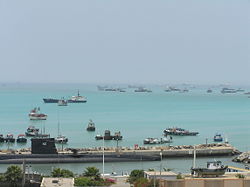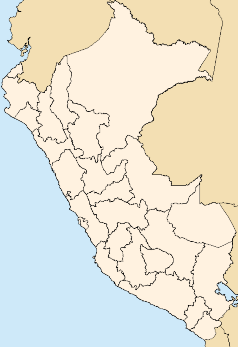Callao
| Callao El Callao |
|||
 |
|||
|
|||
| Nickname(s): El Primer Puerto (the first port) | |||
 Callao
|
|||
| Coordinates: | |||
| Country | |||
|---|---|---|---|
| Region | Callao | ||
| Provinces | Constitutional Province
of Callao |
||
| Founded | 1537 | ||
| Districts |
6 Districts
|
||
| Government | |||
| - Mayor | Félix Moreno | ||
| Area | |||
| - City | 146.98 km² (56.7 sq mi) | ||
| Population (2005 est)[1] | |||
| - Urban | 813,264 | ||
| - Urban Density | 5,608.4/km² (14,525.7/sq mi) | ||
| - Metro | 8,187,398 | ||
| - Demonym | chalaco/a | ||
| Time zone | PET (UTC-5) | ||
| Area code(s) | 14 | ||
| Website: www.municallao.gob.pe | |||
Callao (Spanish: El Callao) is the largest and most important port in Peru. The city is coterminous with the Constitutional Province of Callao, the only province of the Callao Region. Callao is located west of Lima, the country's capital, and is part of the Lima Metropolitan Area, a large metropolis that concentrates almost one-third of Peru's population. Callao borders Lima Province on the north, east and south, and the Pacific Ocean on the west.
Contents |
History
Callao was founded in 1537, just two years after Lima (1535), and soon became the main port for Spanish commerce in the Pacific. The origin of its name is unknown; both Indian (particularly Yunga, or Coastal Peruvian) and Spanish sources are credited, but it is certain that it was known by that name since 1550.
At the height of the Viceroyalty, virtually all goods produced in Peru, Bolivia, and Argentina were carried over the Andes by mule to Callao, to be shipped to Panama, carried overland, and then transported on to Spain via Cuba.
On August 20, 1836, during the Peru-Bolivian Confederacy, President Andrés de Santa Cruz mandated the creation of the Callao Littoral Province (Provincia Litoral del Callao), which had political autonomy in its internal affairs.
During the government of President Ramón Castilla, Callao was given the name of Constitutional Province (Provincia Constitucional), on April 22, 1857. The province's first mayor was Col. Manuel Cipriano Dulanto. However, this new name had no practical difference as the status of Callao was the same as that of any other province, and it belonged, just like all others, to a department (in this case, the Lima Department). The only difference was that all Peruvian provinces had been given that name by law, while Callao was given it by constitutional mandate.
By 1949, Callao was known as one of the biggest centers of coca-based produtcs and cocaine traffic in the world.[2]
As part of the decentralization process promoted by President Alejandro Toledo in 2002, the Callao Region was created, and the Constitutional Province of Callao was no longer part of the Lima Department (now Lima Region).
Notable events
- In 1746, a tsunami caused by an earthquake destroyed the entire port of Callao.
- On 2 May 1866, during the Battle of Callao, the Spanish fleet tried to reconquer independent Peru.
- On June 19,1986 hundreds of prisoners were massacred on El Frontón.
City highlights
Callao is built on and around a peninsula, the district of La Punta, once a wealthy residential neighborhood. An historical fortress, the Castillo de Real Felipe (site of "Rodil's Last Stand"), stands on the promontory overlooking the harbor.
There is also a large naval base in Callao, in which the leader of the Shining Path rebel movement, Abimael Guzmán, and Vladimiro Montesinos, the ex-director of internal security during the Fujimori regime are currently imprisoned.
Lima's Jorge Chávez International Airport is located in Callao.
On a bluff overlooking the harbor sits Colegio Militar Leoncio Prado, the military high school Peruvian author Mario Vargas Llosa attended and made famous in his first novel, La Ciudad y los Perros (1962) (published in English as The Time of the Hero in 1963). The book was later filmed as The City and the Dogs and featured exterior shots of the school. The city also has a university, the National University of Callao.
Callao also has several islands, San Lorenzo (currently a military base), El Frontón (a former high security prison), the Cavinzas, and the Palominos, where a large number of sea lions and sea birds live in a virtually untouched ecosystem. There is currently proposed plans to build a huge naval, terrestrial, and air port on San Lorenzo Island. This project is called the San Lorenzo Megaport Project.
Residents of Callao are known as chalacos.
Callao's football professional team is called Sport Boys.
Districts

Callao is divided into six districts, (Spanish: distritos; singular: distrito), each of which is headed by a mayor (alcalde).
- 1 Bellavista
- 2 Callao (downtown)
- 3 Carmen de la Legua Reynoso
- 4 La Perla
- 5 La Punta
- 6 Ventanilla
* The rest of Callao Region is composed of the islands of San Lorenzo, El Frontón and Cavinzas, which all together have an area of 17.63 square kilometres (6.81 sq mi).
Government
Local government affairs are divided into two levels. Regional matters are handled by the Regional Government of Callao (Gobierno Regional del Callao), which is located in the Bellavista District. Affairs such as city cleaning, promoting of sports and basic services are handled by the Provincial Municipality of Callao, which is headquartered in the Callao District. Also, each of the six district has its own Municipality which handles matters in their respective jurisdictional areas.
Railway
The port is served by the Ferrocarril Central Andino railway, which in 2006 is to be modernised from narrow gauge of 3 feet (914 mm) to the world standard gauge of 4 ft 8½ in (1,435 mm).
References
- ↑ INEI – Censo INEI (2005)
- ↑ The White Goddess, TIME Magazine, April 11, 1949
External links
- Municipality of Callao (in Spanish)
- Chim Pum Callao
- Todo Callao (in Spanish)
- National University of Callao (in Spanish)
- Islas Palomino (Palomino Islands) pictures and videos
- Regional government of Callao
- Callao.Net la Internet del Callao (in Spanish)
- Sport Boys Association (unofficial) (in Spanish)
| Lima and Callao Metropolitan Area | |
|---|---|
| Culture · History · Landmarks · Maps · Notable people · Mayors · Other elected officials · Transportation | |
| Districts | |
| Central Lima | Breña · La Victoria · Lima · Rimac · |
| Residential Lima | Barranco · Jesús María · La Molina · Lince · Magdalena · Miraflores · Pueblo Libre ·San Borja · San Isidro · San Miguel · Santiago de Surco · Surquillo |
| Cono Este | Ate · Cieneguilla · Chaclacayo · El Agustino · Lurigancho (Chosica) · San Luis · Santa Anita |
| Cono Norte | Ancón · Carabayllo · Comas · Independencia · Los Olivos · Puente Piedra · San Juan de Lurigancho · San Martin de Porres · Santa Rosa |
| Cono Sur | Chorrillos · Lurín · Pachacamac · Pucusana · Punta Hermosa · Punta Negra · San Bartolo · San Juan de Miraflores · Santa María del Mar · Villa el Salvador · Villa María del Triunfo |
| Callao | Bellavista · Callao District · Carmen de la Legua Reynoso· La Perla · La Punta · Ventanilla District |
|
|||||
|
||||||||